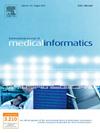Knowledge domain and frontier trends of artificial intelligence applied in solid organ transplantation: A visualization analysis
IF 3.7
2区 医学
Q2 COMPUTER SCIENCE, INFORMATION SYSTEMS
International Journal of Medical Informatics
Pub Date : 2024-12-31
DOI:10.1016/j.ijmedinf.2024.105782
引用次数: 0
Abstract
Background
Solid organ transplantation (SOT) is vital for end-stage organ failure but faces challenges like organ shortage and rejection. Artificial intelligence (AI) offers potential to improve outcomes through better matching, success prediction, and automation. However, the evolution of AI in SOT research remains underexplored. This study uses bibliometric analysis to identify trends, hotspots, and key contributors in the field.
Methods
821 articles from the Web of Science Core Collection were exported for analysis. Microsoft Excel 2021 was used for descriptive statistics. VOSviewer, CiteSpace, Scimago Graphica, and Biblioshiny were used for bibliometric analysis. The ggalluvial package in R was utilized to create Sankey diagrams, and top articles were selected based on citation count.
Results
This analysis reveals the rapid expansion of AI in SOT. Key areas include robotic surgery, organ allocation, outcome prediction, immunosuppression management, and precision medicine. Robotic surgery has improved transplant outcomes. AI algorithms optimize organ matching and enhance fairness. Machine learning models predict outcomes and guide treatment, while AI-based systems advance personalized immunosuppression. AI in precision medicine, including diagnostics and imaging, is crucial for transplant success.
Conclusion
This study highlights AI’s transformative potential in SOT, with significant contributions from countries like the USA, Canada, and the UK. Key institutions such as the University of Toronto and the University of Pittsburgh have played vital roles. However, practical challenges like ethical issues, bias, and data integration remain. Fostering international and interdisciplinary collaborations is crucial for overcoming these challenges and accelerating AI’s integration into clinical practice, ultimately improving patient outcomes.

求助全文
约1分钟内获得全文
求助全文
来源期刊

International Journal of Medical Informatics
医学-计算机:信息系统
CiteScore
8.90
自引率
4.10%
发文量
217
审稿时长
42 days
期刊介绍:
International Journal of Medical Informatics provides an international medium for dissemination of original results and interpretative reviews concerning the field of medical informatics. The Journal emphasizes the evaluation of systems in healthcare settings.
The scope of journal covers:
Information systems, including national or international registration systems, hospital information systems, departmental and/or physician''s office systems, document handling systems, electronic medical record systems, standardization, systems integration etc.;
Computer-aided medical decision support systems using heuristic, algorithmic and/or statistical methods as exemplified in decision theory, protocol development, artificial intelligence, etc.
Educational computer based programs pertaining to medical informatics or medicine in general;
Organizational, economic, social, clinical impact, ethical and cost-benefit aspects of IT applications in health care.
 求助内容:
求助内容: 应助结果提醒方式:
应助结果提醒方式:


